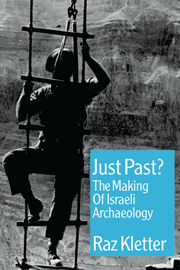Book contents
- Frontmatter
- Dedication
- Contents
- List of illustrations
- Introduction
- Acknowledgements
- Abbreviations
- 1 Archaeology and the 1948 War
- 2 Abandoned places, new places
- 3 Foreign aid
- 4 Frozen funds
- 5 A battalion of guards
- 6 Relief work
- 7 Man robs his land: “agreement” with General Dayan
- 8 “Gold of Ophir for Beth-Horon”: 3,000 shekels
- 9 The building beyond the border: the PAM, 1948–67
- 10 A building of dreams: a home for the IDAM and the origins of the Israel Museum, Jerusalem
- 11 A dead man on the council: the story of the supreme archaeological body in Israel
- 12 “But trust comes from the heart”: travels with the Government Tourist Corporation
- 13 “Whether in a courtyard of a synagogue, in a courtyard adjacent to a synagogue, or under a synagogue”: the Safad affair
- 14 The policy of salvage and early Israeli excavations
- 15 Myths and conclusions
- Appendix: other documents from the IDAM files
- Bibliography
- Author index
- Index
8 - “Gold of Ophir for Beth-Horon”: 3,000 shekels
- Frontmatter
- Dedication
- Contents
- List of illustrations
- Introduction
- Acknowledgements
- Abbreviations
- 1 Archaeology and the 1948 War
- 2 Abandoned places, new places
- 3 Foreign aid
- 4 Frozen funds
- 5 A battalion of guards
- 6 Relief work
- 7 Man robs his land: “agreement” with General Dayan
- 8 “Gold of Ophir for Beth-Horon”: 3,000 shekels
- 9 The building beyond the border: the PAM, 1948–67
- 10 A building of dreams: a home for the IDAM and the origins of the Israel Museum, Jerusalem
- 11 A dead man on the council: the story of the supreme archaeological body in Israel
- 12 “But trust comes from the heart”: travels with the Government Tourist Corporation
- 13 “Whether in a courtyard of a synagogue, in a courtyard adjacent to a synagogue, or under a synagogue”: the Safad affair
- 14 The policy of salvage and early Israeli excavations
- 15 Myths and conclusions
- Appendix: other documents from the IDAM files
- Bibliography
- Author index
- Index
Summary
Everything the dead predicted has turned out completely different.
Or a little different – which is to say, completely different.
Szymborska, “The Letters to the Dead” (1997: 118)The late Iron Age ostracon “Gold of Ophir for Beth-Horon 30 Shekels” is famous. It was first published by B. Mazar (1951: 66–7, Fig. 19.3), and has received considerable attention ever since. I have nothing to add to its reading or historical significance, but wish to present its tortuous journey after it was found.
Most inscribed Hebrew seals and ostraca are not found in scientific excavations, but are acquired through the antiquities markets. Any data provided, if at all, by dealers about their origins are doubtful. The reasons are clear: if the object was found after 1978, its trade is forbidden since it is the property of the state, under Israel's Antiquities Law (AL 1978). The honest finder must inform the IAA immediately and, if required, deliver the find into the hands of the state for examination, and in certain cases acquisition. Hence revealing the source may result in supervision or excavation, preventing accumulation of other finds from the same site. Antiquities dealers claim that all objects for sale were found before 1978, and are thus not under jurisdiction of the 1978 Antiquities Law (see Amikam 1983; Ariel 1986, 1987; Borodkin 1995; Zissu 1996; Bisheh 2001; Davies 2001; Herscher 2001; in general also Vitelli 1996).
- Type
- Chapter
- Information
- Just Past?The Making of Israeli Archaeology, pp. 165 - 173Publisher: Acumen PublishingPrint publication year: 2006



